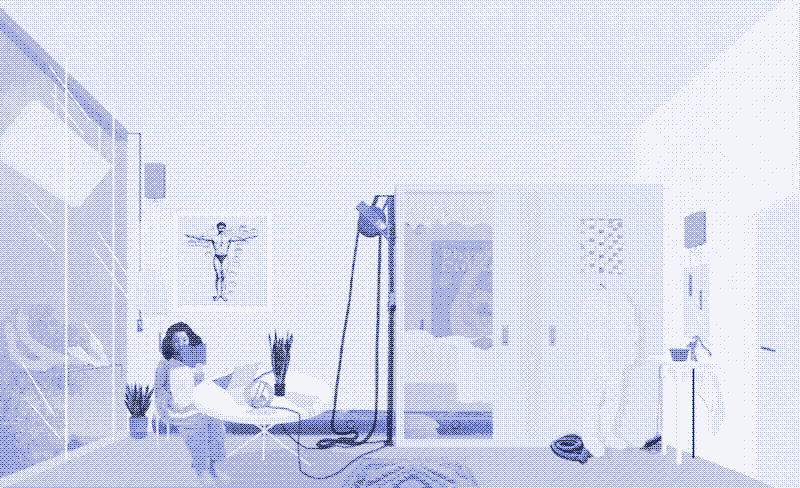
Unlike solar and wind energy, human power is always available, no matter the season or time of day. Unlike fossil fuels, human power can be a clean energy source, and its potential increases as the human population grows. In the Human Power Plant, Low-tech Magazine and artist Melle Smets investigate the feasibility of human energy production in the 21st century.
To find out if human power can sustain a modern lifestyle, we are designing plans to convert a 22 floors vacant tower building on the campus of Utrecht University in the Netherlands into an entirely human powered student community for 750 people. We’re also constructing a working prototype of the human power plant that supplies the community with energy.
The Human Power Plant is both a technical and a social challenge. A technical challenge, because there’s a lack of scientific and technological research into human power production. A social challenge, because unlike a wind turbine, a solar panel or an oil barrel, a human needs to be motivated in order to produce energy.
The Rise and Fall of Human Power
Throughout most of history, humans have been the most important source of mechanical energy. Building cities, digging canals, producing food, washing clothes, communication and transportation: it all happened with human muscle power as the main source of energy. Human power was complemented with animal power, and windmills and watermills became increasingly important from the middle ages onwards. Most work, however, we carried out ourselves.
These days, human power plays virtually no role anymore. We have automated and motorised even the smallest physical efforts. Mechanical energy is now largely provided by fossil fuels, either as a primary fuel or converted to electricity. This ‘progress’ comes at a price. Industrial society is totally dependent on a steady supply of fossil fuels and electricity, which makes it very vulnerable to an interruption in this supply.
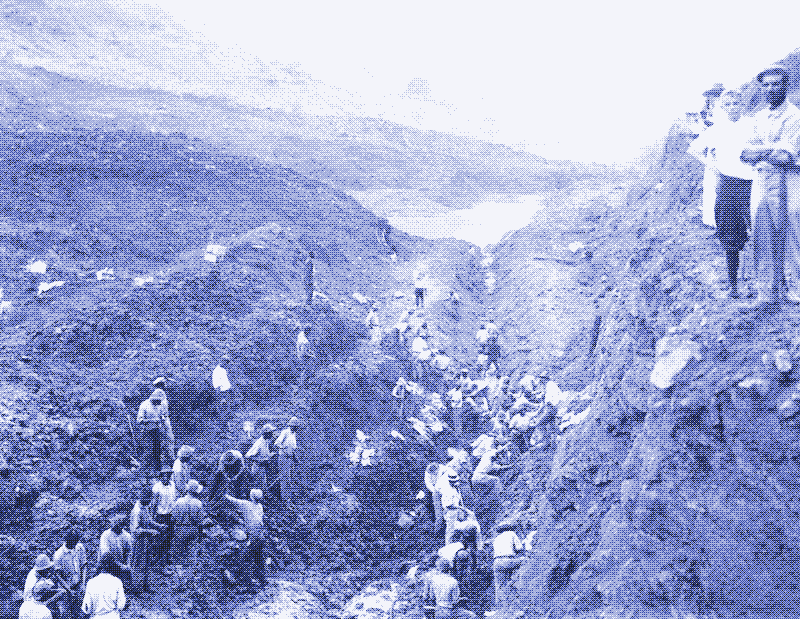
Furthermore, fossil fuels are not infinitely available and their large-scale use causes a host of other problems. On the other hand, renewable energy sources such as wind and solar power are not always available, and their manufacturing is also dependent on fossil fuels. Meanwhile, in order to keep in shape and stay healthy, people go to the gym to exercise, generating energy that’s wasted. The Human Power Plant wants to restore the connection between energy demand and energy supply.
Why Human Power?
Compared with fossil fuels and renewable energy sources, human power has a lot of advantages. A human can generate at least as much power as a 1 m2 solar PV panel on a sunny day — and as much as 10 m2 of solar PV panels on a heavy overcast day. Human power is a dispatchable energy source, just like fossil fuels. Its power output is not dependent on the season, the weather or the time of the day. In fact, humans can be considered renewable energy sources and batteries at the same time.
Unlike fossil fuels, human power can be a clean energy source, which produces little or no air pollution and soil contamination. Moreover, the potential of human power increases as the human population grows, while all other energy sources need to be shared among an ever-growing amount of people. Furthermore, unlike solar panels, wind turbines, and batteries, humans don’t need to be manufactured in a factory. In combination with the right diet, human power is carbon neutral.
The potential of human power increases as the human population grows, while all other energy sources need to be shared among an ever-growing amount of people.
Finally, humans are all-round power sources, just like fossil fuels. They not only supply muscle power that can be converted to mechanical energy or electricity, but also thermal energy, especially during exercise: a physically active human being can generate up to 500 watts of body heat. Furthermore, human waste can be converted to biogas and fertiliser. Arguably, human power is the most versatile and most sustainable power source on Earth.
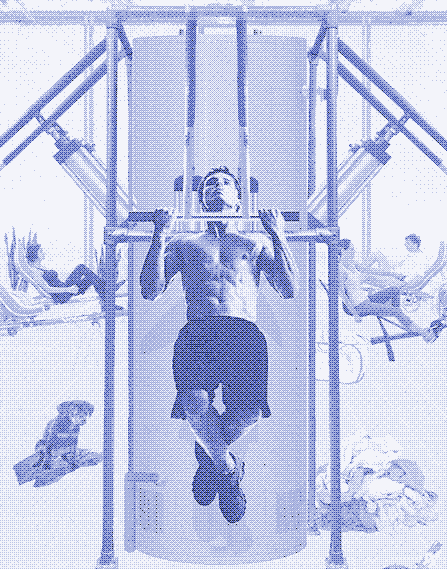
Modern technology has greatly improved the potential of human power production. On the one hand, many electric devices have become very energy efficient. For example, solid state lighting consumes roughly ten times less power than old-fashioned lightbulbs, so that a quick workout can supply many hours of light. On the other hand, we now have much better technology for human power production, ranging from sophisticated exercise machines to biogas power plants.
Lessons from the Gym
The power output of a human being is determined by three factors: the person, the duration of the effort, and the mechanical device that is used to convert human power into useful energy — human power generation is often a symbiosis between man and tool or machine. Our legs are roughly four times stronger than our arms, which means that a human on a stationary bicycle machine can produce more power (75 to 100 watts) than a human operating a small hand crank (10 to 30 watts).
During shorter efforts, the mechanical power output of a human being can increase substantially: up to 500 watts on a bicycle and up to 150 watts while operating a hand crank over a period of one minute. However, age, gender and fitness also play an important role. Athletes can generate more power for a longer period of time — up to 2,000 watts during three seconds, or up to 400 watts during one hour. So far the theory, which is far from complete.
Exercise machines for strength training are an interesting addition to stationary cycling machines for human power production.
During the research phase for the Human Power Plant, we followed a fitness programme to become better human power sources. This was a very instructive experience. One of the first things we learned is that there are important differences between individuals, even if they have similar age, gender and fitness.
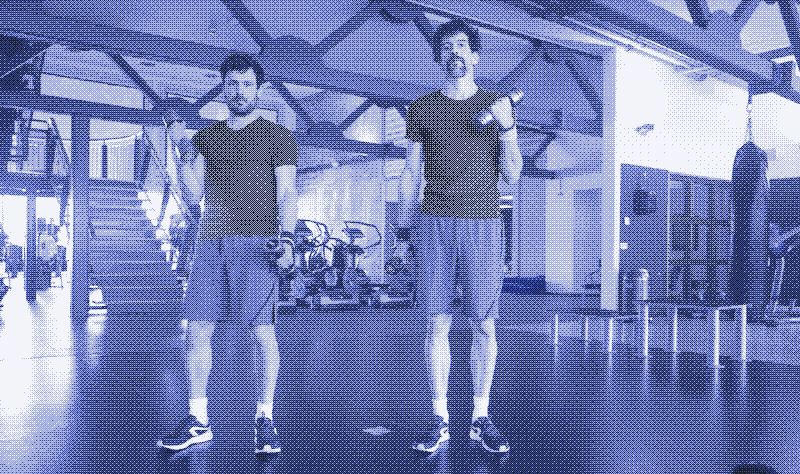
Melle, the powerhouse in our team, could lift a heavier weight on almost any exercise machine. Kris, on the other hand, appeared to have better endurance, and could beat Melle with triceps and shoulder exercises. Such differences should be taken into account in order to achieve optimal energy production - there is no ready-made solution.
We also found out that exercise machines for strength training can produce a lot of power in a very short time, making them an interesting addition to stationary cycling machines for human power production. A five minute workout (including two breaks of one minute each) can supply more than 15 Wh of electricity, enough to charge a quarter of a laptop’s battery or to power a desk lamp for 3 hours.
Finally, we quickly discovered that gyms are pretty boring places. The exercise equipment is often positioned in such a way that people all look in the same direction, which excludes all but the most primitive communication. And, while a stationary bicycle is considered to be the most energy-efficient human power machine, we found out that stationary cycling is no fun at all.
How to Motivate Human Power?
The last point deserves extra attention. Unlike a windmill, a solar panel or an oil barrel, human power needs to be motivated in order to produce energy. If we make a switch to human power production, would everybody generate their own power for the sake of sustainability? Would people pay others to do it for them? Or, would people force others to do it for them?

A financial reward won’t do the trick, because at the current energy prices in the Netherlands, a human generating electricity would earn only 0.015€ per hour. Consequently, unless environmental awareness increases dramatically, the use of human power could open the door to new forms of slavery. Is such slavery justified for a reduction in CO2-emissions? Could we force refugees or criminals to produce power?
At the current energy prices in the Netherlands, a human generating electricity would earn only 0.015€ per hour.
These are disturbing questions, because the history of human power is — broadly — also the history of slavery. These days we import oil, coal and uranium, in the past we imported slaves. There may be a third possibility. We can try and motivate people by making human energy production more fun, social, and exciting.
The few commercially available devices for human energy production are entirely focused on energy efficiency — there’s no attention to fun or motivation. They are also designed for emergency purposes, not for prolonged and daily use. For example, most hand cranks are made as compact as possible, while a larger device would be much more comfortable to use.
Designing the Prototype
For the design of our prototype human power plant, we wanted to address these issues. We teamed up with makers and sports coaches to develop fitness machines that are suited for different types of human power sources, are fun too use, and produce a maximum amount of power.

To make power production more social, we decided that power producers should be able to talk to each other. They can even bring their pets to help with power production, creating a cosy and home-like atmosphere. This is not a new idea: dogs were commonly used as a source of mechanical power in pre-industrial times, and also provided their owners with a source of warmth.
Water Under Pressure
For extra motivation, all exercise machines in our prototype human power plant are facing a jacuzzi and shower where girls are invited to encourage the boys to flex their muscles and generate more power. Of course, the sex roles could be reversed, but during the first experiments we discovered that this is less energy-efficient. Girls don’t seem to get motivated by guys in jacuzzis, at least not to the extent that guys get motivated by girls in jacuzzis. 1
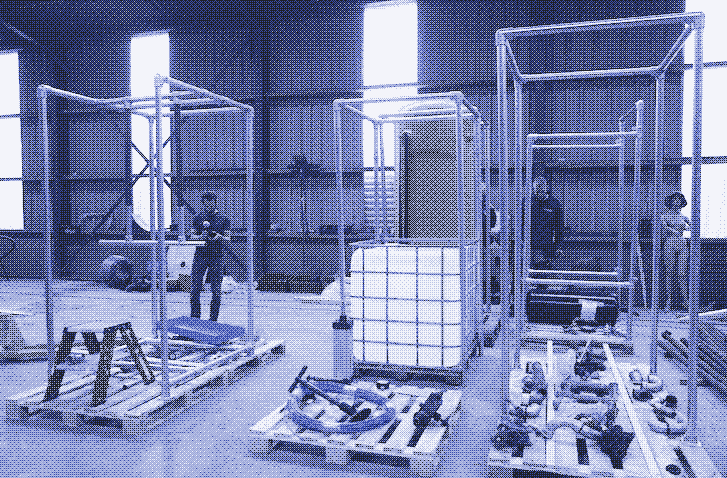
The jacuzzi is not a gimmick, but an essential part of the prototype human power plant. That’s because we opted for water under pressure as the energy carrier. The kinetic energy produced by humans and their pets is pumped into a pressure vessel, which produces water under pressure that is led to water turbines which supply mechanical energy and electricity. The jacuzzi is the receiving reservoir of this closed system.
With the choice for water under pressure, we want to make energy more visible and audible. More importantly, however, it allows us to produce electricity without the use of batteries and electronics — which are not sustainable components. In our human power plant, the hydraulic accumulator takes the place of the battery and the voltage regulator. Small variations in human power production can be smoothed out, keeping the voltage constant. Longer term energy storage is provided by the humans themselves.
For Rent: 750 Human Powered Student Rooms
To find out if we could sustain a modern lifestyle with human power alone, we teamed up with architects to design plans for the conversion of a 22 floors tower building into an entirely human powered student community of 750 people.
The Willem C. Van Unnik building is the tallest building on the campus of Utrecht University. The concrete, steel and glass monolith, which occupies a central position on the campus, was built in the late 1960s and has been mostly empty for years. Maintaining it is an important cost for the university, who owns the building.
A time schedule tells the students when they have to produce elelectricity and heat, and when to perform other services for the community.
Because the university has the ambition to become carbon neutral in 2030, we propose to turn a problem into an opportunity. The ecological footprint of the human powered Van Unnik student community will be close to zero, and the building is already there.

Each student in the human powered Van Unnik student building is responsible for generating the electricity that’s used in his or her individual room. The lower floors of the building are reserved for communal energy production, providing both electricity and warmth. This energy is used to heat the building, prepare food, wash clothes, take showers, and so on.
More energy is supplied by a biogas plant, which is operated by the students and runs on their food waste and excrements. A time schedule tells every student when he or she has to produce electricity and heat, and when to perform other services for the community.
Power Generation Schedule
According to our preliminary calculations, an entirely human powered student building is achievable. The students would maintain a modern lifestyle, including hot showers, computers, and washing machines. On the other hand, they would have to produce energy for 2 to 6 hours per day, depending on the season and their individual and communal preferences.

A human powered student community has enormous potential for a reduction in energy use. If students have to generate their own power, they are much less likely to waste it. How far would students go to reduce their efforts? Would hot showers go out of fashion? Would salads be the next culinary trend? Would typewriters make a comeback?
Energy use is also lowered by encouraging the communal organisation of daily household tasks, just like in the old days. Finally, the human powered student community applies low-tech solutions, such as fireless cookers, thermal underclothing, and heat exchange showers, which all maximize comfort in the context of a limited energy supply.
The design of the building and the construction of the prototype human power plant is documented on a separate blog: Human Power Plant. It’s a work-in-progress, and comments are welcome. Once the project is complete, we will post an update on Low-tech Magazine.
The Human Power Plant is part of the Zero Footprint Campus project, for which 12 artists examine sustainability.
Reactions
To make a comment, please send an e-mail to solar (at) lowtechmagazine (dot) com. Your e-mail address is not used for other purposes, and will be deleted after the comment is published. If you don’t want your real name to be published, sign the e-mail with the name you want to appear.
Reactions
Tom
Very interesting project. If a humble armchair engineer may, one human energy source that I do not see used in your drawing is the potiential energy generated by going up stairs. Perhaps a different system for going down might accomplish this. I’m thinking of some sort of rope coiled around a pump that had a seat at its end. Sit on the seat, and your weight causes the seat to go down, the rope to unwind, and the pump to gravity battery.
Would seriously consider moving in if I lived in the area.
PeteC
“Could We Run Modern Society on Human Power Alone?”
TL;DR: No :)
If Wikipedia’s information is correct, folks in the Netherlands use 6,346 kWh of electricity average per capita per year. Using your human power generation figure (100W on a stationary bicycle), and assuming that your adult population can be persuaded to produce an hour of electricity per day, I calculate 24kWh per capita per year.
That would put the per capita electricity usage on par with Somalia and Chad - so a society could function, but certainly not a modern one.
tapsa
nice project! it is good to remember though that many ‘problems’ of the modern society are self-invented, you don’t really need a machine to solve them but you just need to stop being lazy and do those tasks manually.
Lee Johnson
This an excellent idea - logically sound, and the vertical structure saves space too. But there is an even more direct approach to storing and distributing human energy.
Given an ample amount of land, a human can interact with it, through his or her labor, and produce chemical energy that can be stored for periods of time when monitored in cycles. Raising livestock, growing gardens, and cutting firewood are just a few examples of energy harvesting activities that require human exertion. Add to that the necessity of hand built structures that house tenants, equipment, and livestock in the winter, and there’s even more necessary human labor required.
This is a more direct transfer of human energy into stored energy, because there is less fuel required to ferry food to a market where it is purchased and brought back to the communal living space. Perhaps the ultra efficient communal space proposed here could be at the center of the operational land area, to provide a base for citizens to gather and coordinate, while tasks performed in the field are considered contributions for those who do not wish to monotonously use exercise equipment to generate energy for the group.
John Weber
Plant, animal and human power worked for 100,000 years plus.
All the things in our world have an industrial history. Behind the computer, the T-shirt, the vacuum cleaner is an industrial infrastructure fired by energy (fossil fuels mainly). Each component of our car or refrigerator has an industrial history. Mainly unseen and out of mind, this global industrial infrastructure touches every aspect of our lives. It pervades our daily living from the articles it produces, to its effect on the economy and employment, as well as its effects on the environment.
The whole picture needs to be included not just the installed device.
This essay looks at the energy used in copper, glass and other common tools of everyday life. There are also videos of other necessay parts of our life styles - WINDOW SCREEN – A SYRINGE – MEDICAL PLASTIC TUBING - A CPU FOR YOUR COMPUTER – AN ELECTRIC MOTOR – A FAN (GLOBAL WARMING) - FARM MACHINERY.
http://sunweber.blogspot.com/2017/05/renewable-future_26.html
Crabapple
First you/we can not get 47% of the people to work for the food that the snap program gives them for free. You might get people to work between solar & wind gapes, but persons are living off the grid with only solar now, so it can be done.
Also, zero net homes/buildings can reduce the amount of energy needed. Reduction is the great form of power for the human power plant.If you can live without it then no need for the power to keep it going. Candle or led lights will help reduce power needs.
C.M. Mayo
This is brilliant. It made me smile. I will now go churn some butter.
Jay Gaff
Have you seen the TV show “Black Mirror”, episode “Fifteen Million Merits”?
viveik
Will definitely come to the “open day” when it starts.
Its reported that the complete exercise is pretty much walking with weights. Exercises like Farmer’s carry, pulling and pushing weights are supposed to provide the best bang for the buck and seem easy to turn into energy generating machines…
Best wishes with the project.
Hilton Dier
It’s an interesting concept, but I am doubtful about the embodied energy in the devices used. Will the human energy collected by using the device over its service life significantly exceed the energy used to make the device?
In the case of pedal powered electric generators the answer has been established: no. Too much copper, steel, and plastic involved. Even the direct pedal powered tools of the early industrial revolution relied on the non-sustainable extraction of coal. You’d have to go back to all-wood spring pole lathes to get a reasonable Energy ROI.
We are just too feeble compared to the energy requirements of our daily lives and, more importantly, the energy investments in established infrastructure that supports our lives.
Edgar
@Jay Gaff
Yes I have but I’ve also watched the TV show Utopia on Channel 4 and I both solutions scare me. Degrowth is the best solution in my opinion.
franky
In ancient times, navies were powered by human power. Captive human power.
Just 200 yrs ago, human power cultivated and harvested cotton in the American South. That turned out well.
In “Matrix”, Neo woke up and convinced others that they will no longer be captive human power
Darkest Yorkshire
You could store rainwater just below the roof and when extra electricity is needed a valve opens and it flows straight down a pipe to a turbine at ground level. It would have a large power output because of the extremely high head.
Wallebot
In the bike rent systems, bike parking in high places lost all bike, and lower parking suffer overbooking.
This bikes need be transporte to higher places in vans and trailers.
I think to park in higher parking need a good prix, since free rent to bus ticket for return to recover other bike to climb with it. Its a injustice that a bike climber cannot do this jobs witthout lost money.
Somebody can do exercise and help society at time. But system don`t help him
It’s a example of human power not being used.
Dairokkan
Interesting idea, but it is plagued by errors and mistakes.
Firs of all, humans are naturally lazy. An I somehow can not imagine how they will happily jump on stationary bike and generate power for hours, maybe in some dystopic scenario or those that want get in shape, but if you took sample of general population, how much of them really do something for their health. Despite all promotion of healthy lifestyle, only small portion of people exercise and obesity is still greater problem.
Second human heat have to be refined by some heat pump, yes people can heat building, but this is connected with large amount of humidity etc. that will on other hand be problematic and as well every living organism produces carbon dioxide, that means that air have to be renewed
Third those energy efficient lightbulbs saves energy in situ, but their production is quiet resource intensive, that is not good idea.
to: Hilton Dier
Metal production can be based on renewable fuels as it was well into 19th century in parts of world, but it needs wast resources of wood and it could be problematic.
to: Edgar
Greatest problem of degrowth and such ideas, permaculture for example is that general population is not willing to participate in it. Look what happened with renewables and energy efficiency. Instead of self production of electricity, lowering demand and so, we try to use it for supply of current levels of consumption. Biomass is not used where it is produced, but transported hundreds of miles to former coal power plants. Energy efficiency is dependent on complicated technology. Instead of passive heating system and clever building design we rely on traditional design only with thick insulation and heat pumps.
People are not willing to change their ways, look on transportation. they still prefer cars to buses and trains, well partly it’s problem of railways and price of public transport, but there is no push for better trains more often, new railways and stations, quiet contrary, they often want to get rid off them. On other hand every village want it’s road bypass, every city it’s highway, large car parks and as measurement of progress and development they took how many malls they have on outskirts.
Rolf
This project is nothing more than an interesting thought experiment. Please do not take it as venturing into an even remotely realitsic solution.
The exess energy the inhabitants are producing of course has to come from somewhere. 1st law of thermodynamics: Energy does not appear out of thin air, it can only be converted from one form into the other. In this case the energy comes from food. So the participants have to consume more food in order to produce this energy. The article only briefly touches on this by stating that “In combination with the right diet, human power is carbon neutral.”. Alone our food system is nowhere near carbon neutral. If it were we would really be a big step closer fighting climate change. Agriculture is a major contributor of climate gases.
So instead of making it appear like the project discovered some yet untapped source of freely available energy that is smartly utilized, it should do a comparison that is approriate here: Compare the “human powerered infrastructure” with other forms of energy source, for example in terms of “agricultural land required” and then set the required area into perspective. I am pretty sure that “powered by photovoltaic panels” beats “grow crop to feed humans to power lightbulb” hands down.
So again, while it is a nice and provocative thought experiment, please do not take this actually serious.
PS: I wish they would put more focus on human powered machines that actually make sense, like the pedal powered blender, pointing out other benefits of humans powering tools, like independance from the grid and availability of utility.
Javier
I’m the only one who thinks that the idea of having the women “motivating” men in a jacuzzi is a really sexist idea?
Theresa
I’ve often wondered about falling waste water in buildings. Couldn’t some kind of micro water wheel be used? Same in rainwater drainage?
Someone tried to explain why it wouldn’t be possible but I’ve often wondered why we can’t recover waste noise to convert to energy eg, operating and vibration noise from machinery, etc
G
Rolf: Agreed, thermodynamics. Though, humans are incredibly efficient energy-converters: a bicycle gets the equivalent of 1,200 miles per gallon.
Javier: I noticed that as well. Even if the reported difference between genders is empirically true, the ’emotional labour’ on the part of women to get men ’energised’ as it were, is unacceptable in a civilised society.
Theresa: Solid or semi-solid waste would clog the turbine and shut it down quickly.
OK, so:
This is a great experiment. It’s to be hoped that there will be a full effort to collect as much empirical data as possible without producing a panopticon.
Children, elders (much above 50), and people with disabilities, need not apply. This is only suitable for the young and athletic, such as in dorms, and in military barracks under peacetime conditions (in wartime we want our service members to be able to devote their full energy to the tasks of defence).
The greatest impact any human can have on reducing climate change and ecological overshoot generally, is to have one fewer child. True, as confirmed in a recent report on comparative behavioural climate impacts. (I don’t have a URL off the top of my head, should be easy to find with a search.)
The key factors in reducing birth rate are equality for women, and economic security. When women have equal education, legal status, job opportunities, and of course reproductive control, the birth rate rapidly and voluntarily declines to a level slightly below replacement: population decreases toward a sustainable level. See also France and Japan. However, the governments of said countries have deliberately sought to thwart what they should recognise as a major advantage, by offering financial incentives to have more babies! The effect of that is equivalent to the intention to burn coal. We have got to incentivise population decline, not dis-incentivise it.
The most important thing the world could do to reduce climate impact is to promote feminist revolution worldwide, with the goal of full equality for all women and full control of their own reproduction. Some countries, where women are presently ‘property’ of men, will have to be dragged kicking and screaming into the future, but international trade incentives (both carrots and sticks) should help. Alongside this, guarantee potable water and food security, sanitation, vaccination, and education, to all the world’s peoples (paying for this will require seriously progressive tax policies).
That said, empirical findings from the experimental dormitory will be of enormous value in lowering the energy footprint of dwellings and workplaces. And it’s also highly likely that if a person spends even an hour a day exercising to produce energy, they will have a much greater appreciation of their energy usage habits, and will tend to have a strong sense of ‘buy-in’ that in turn will encourage substantial conservation.
One way to get people producing energy like eagerly buzzing bees, is to attach a ‘screen’ to the stationary bike. Let people produce the energy needed for indulging in screen entertainments such as TV, movies, reading online, using ‘social’ media, etc. Given the addictive nature of screen entertainments, there should be no problem getting people to pedal away their hours after work. Yes I’m quite serious about this.
vocalpatriot
Short answer: no.
Thunder
Wow, communal work quotas, one child policies, and settling for lower standards of living in the name of equality? It’s so brilliant that I can’t believe nobody else in the world ever thought of it! We could have had utopia everywhere it would have been implemented!
Seriously, aren’t our priorities severely misplaced if we’re willing to rip babies out of women’s pregnant bodies and lower living standards for everybody (unless you’re an official), just to sustain the earth on its axis?
And how is it sexist for women to motivate men to work? Have you never had a girlfriend or wife before? The quickest and most straight forward way to fix a lot of modern societal problems would be get women out of the workplace, since nearly all of them want to stay home and raise children after pregnancy anyway, as a decent mother should.
That way, men would have millions of better job opportunities available to them while having fulfillment in providing security for their loved ones, and their women would also feel more secure because they will be less concerned about whether their men can keep up with their work success, and be grateful that they are taken care of.
kris de decker
@ Rolf [#16]
Your point is addressed in the latest post: http://www.humanpowerplant.be/2017/09/how-to-feed-a-human-powered-building.html
The Dutch eat too much: they could produce power for 2 to 3 hours without extra food intake.
Carrie
On the topic of if people would coerce other people to work for them why not make everything powered directly by who is using it? We could have special batteries attached to our bodies that fill with energy threw out our day, we can take a component off and plug it into some sort of household storage unit then have our power just there. as for powering lights in a whole community building as opposed to just powering your washing machine or charging your phone, we could just be issued a power tax. Turning energy into a form of currency so the city collects stored power from everyone like a tax to run communal structures. Every individual will still power their own individual things to the best extent. Electronics will be battery powered and machines like microwaves and washers will be powered by tools that we operate to make them function.
Susanna
I came across this article when researching and I was immediately intrigued and thought the concept was well thought out and intelligently designed…but then, mid-way through the article, I read the ‘water under pressure’ section and was shocked at the dated, sexist, unacademic statements. That section, and even more so that intentional and demeaning setup existing within the project, is completely unneeded and inappropriate.
Kris De Decker
Sorry to offend you. But it’s not an academic paper, it’s an art project. You call the statements “dated” but actually we included them to show that power relations between genders are also determined by the energy source upon which society runs – and that won’t be fossil fuels forever.
Our question “Could we run modern society on human power alone?” raises a lot of other questions, whether you (or we) like them or not. We’re now doing a scenario about human powered hospitals and be assured that it brings even more concerns.
The whole point of the project outlined above is: how do we motivate spoiled people in western societies to live independently of fossil fuels? I hope you are just as critical of car commercials and all the other sexist advertisements around us cause all we did is appeal to the most primitive instinct of men to promote (and produce more) renewable energy.